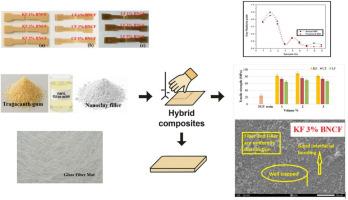黄芪胶在混杂复合材料中天然纤维-聚合物界面的绿色增容剂
Q1 Environmental Science
引用次数: 0
摘要
黄芪属植物是黄芪胶(TG)的天然来源,是一种新型的高分子复合材料绿色增容剂。与传统的石化偶联剂不同,它在改善纤维-基质结合和促进纳米填料分散方面具有多种用途。本研究以黄棘胶和膨润土纳米粘土改性乙烯基酯树脂(TGV)为基体,将玻璃纤维与天然纤维(木棉、棉花和丝瓜)结合,制备了混合复合材料。采用L9正交阵列,采用灰色关联田口分析(GRTA)提高Minitab 17的力学性能。预期的灰色关联度和实际的灰色关联度之间的差异很小。实际值和预测值的趋势之间只有很小的百分比差异,这是非常相似的。平均偏差仅为4.15%。扫描电镜检查证实,tg基生物纳米复合材料具有增强的界面附着力。未处理的K/G/K纤维垫复合材料的抗冲击强度为28 kJ/m2,抗拉强度为89.1 MPa。这些发现证明了TG作为一种环保相容剂的多功能作用,使设计可持续的高性能生物纳米复合材料成为可能。本文章由计算机程序翻译,如有差异,请以英文原文为准。

Tragacanth gum as a green compatibilizer for natural fiber-polymer interfaces in hybrid composites
Astragalus plant is a natural source of tragacanth gum (TG), a polysaccharide that has been investigated as a new green compatibilizer for polymer composites. Unlike traditional petrochemical-based coupling agents, it serves many purposes in improving fiber–matrix bonding and promoting nanofiller dispersion. A tragacanth gum and bentonite nanoclay-modified vinyl ester resin (TGV) matrix was used in this study to create hybrid composites by combining glass fibers with natural fibers (kapok, cotton, and luffa). An L9 orthogonal array was used in Minitab 17 to enhance mechanical properties using Grey Relational Taguchi Analysis (GRTA). There was very little variation between the expected and actual grey relational grades. There was only a slight percentage variation between the actual and forecasted values' trends, which are very similar. The deviation on average was only 4.15 %. SEM examination verified that the TG-based bionanocomposites had enhanced interfacial adhesion. The untreated K/G/K fiber mat composites reinforced with TGV and 3 vol% nanoclay performed the best among the investigated configurations, demonstrating an impact strength of 28 kJ/m2 and a tensile strength of 89.1 MPa. These findings demonstrated the multifunctional role of the TG as an eco-friendly compatibilizer, enabling the design of sustainable, high-performance bionanocomposites.
求助全文
通过发布文献求助,成功后即可免费获取论文全文。
去求助
来源期刊

Bioresource Technology Reports
Environmental Science-Environmental Engineering
CiteScore
7.20
自引率
0.00%
发文量
390
审稿时长
28 days
 求助内容:
求助内容: 应助结果提醒方式:
应助结果提醒方式:


